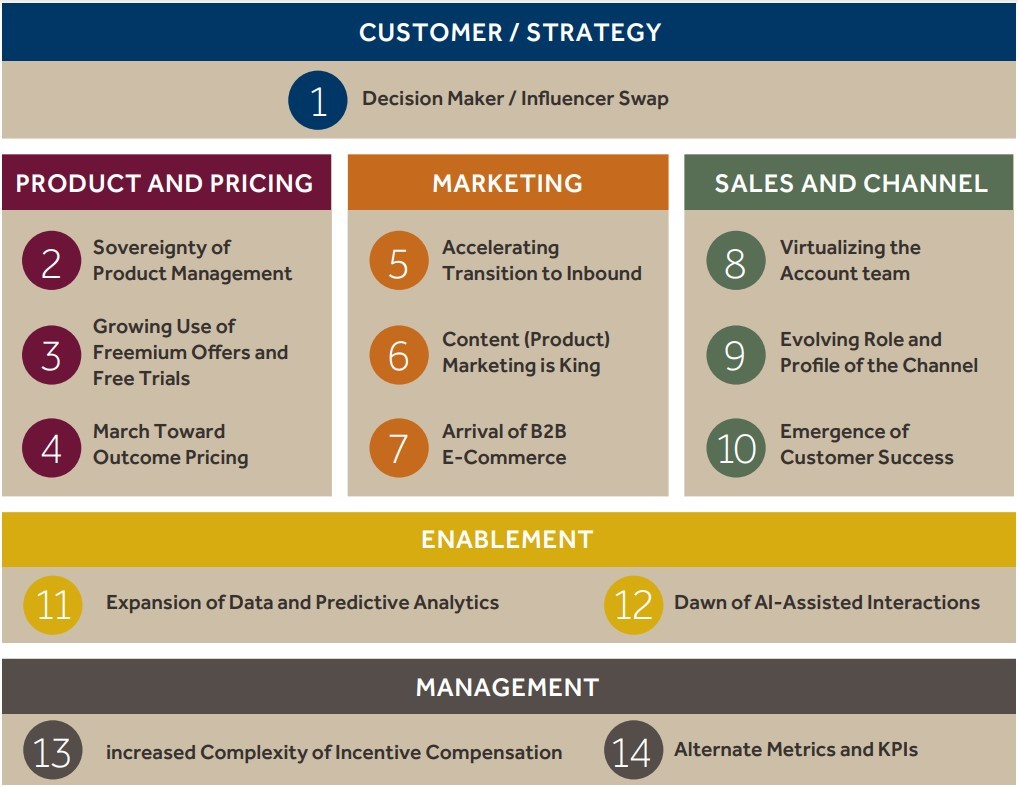Is Revenue Raining Out of Your Cloud?

Traditional technology hardware and software companies are seeing a significant share of their growth from the cloud. With legacy revenue streams declining—and in some cases declining rapidly—it is imperative that companies make the transition to the cloud effectively. This is no simple task. The shift has major implications for all elements of the go-to-market (GTM) approach, from customer/strategy to enablement and management. Some of these changes are not entirely unique to the cloud, but all are magnified or accelerated with cloud delivery.
There are 14 major differences between the GTM approach for traditional systems and the approach for the cloud. Some of these changes may not be applicable to certain businesses, and the way in which each company approaches them will differ based on size, market, structure, and other factors. However, all 14 are such significant shifts that each must be considered by every tech player transitioning to the cloud.

Table of Contents
Customer/Strategy
- Decision Maker/Influencer Swap.
The relative importance of business vs. IT decision makers reverses with the cloud. Where IT often dominates the purchasing decision with traditional technology, business decision makers take the lead with cloud (particularly with SaaS) and the role of IT shifts to one of managing compliance and corporate policies in areas such as security, identity, and business continuity. This change ultimately impacts every element of the GTM model. Vendors must reevaluate their GTM structure with the business customer in mind.
Product And Pricing
- The sovereignty of Product Management.
While product management is always important, its criticality is multiplied in a cloud model. The product becomes something that can only be configured by the customer; product release cycles move from highly gated events to continuous improvement, and the ability to test alternatives and get real-time visibility into usage creates a wealth of insight. These changes elevate the importance of the product manager’s role, but most traditional technology companies have not empowered this role effectively. As organizations move to the cloud, they must review the product management function to ensure the requisite authority and capabilities exist for success. - Growing Use of Freemium Offers and Free Trials.
Free trials and/or freemium offers are a powerful entry point for the cloud. While particularly applicable to ‘simple’ products, most leading cloud players offer some form of freemium service or free trial, including those with ‘complex’ business applications. To be effective, these offers and the accompanying customer experience must be thoughtfully designed and managed.
A freemium offer must be sufficiently capable for the customer to see the benefit, but not so capable as to eliminate the need for a paid upgrade. The goal of a free trial is to give the user a clear understanding of the benefits of adoption and the path to get there—and do so in a short time. Both must start with a simple and compelling self-setup experience and be followed up by proactive and reactive engagement. Vendors should invest to ensure free trials and/or freemium services provide an experience that naturally drives high conversion. - March Toward Outcome Pricing.
Driven by cloud offerings, pricing models in the technology world have been evolving steadily away from legacy models where the customer pays most costs upfront. Newer pricing models involve lower up-front costs which grow based on usage and, eventually, outcomes. This evolution has significant implications for the burden of risk. Where risk used to lie almost entirely with
the customer, it is now being transferred to the vendor. For instance, the cost of the initial sale is reduced, but the burden for ongoing enablement is notably increased. On the upside, the customer’s lifetime value (LTV) under a subscription model can often exceed the LTV under legacy pricing—and the elimination of ‘upgrade events’ also eliminates a typical churn risk point. Vendors must carefully define pricing models while in parallel ensuring that pre- and post-sales customer engagement is effective at managing the incremental risk.
Marketing
- Accelerating Transition to Inbound.
Today’s customers take a very proactive approach when researching the technology. Identifying customers early in the search process using inbound search marketing (e.g., SEO, content marketing, paid search) and targeted digital advertising to generate marketing-qualified leads is paramount. While true everywhere, this is particularly critical for vendors competing in the cloud where competitors can transition the research process directly to a trial or even an online sale. Customers who provide an email address (e.g., to download a white paper) make accessible a wealth of demographic and psychographic information for selective targeting. They also create an opportunity for nurture marketing to build brand recognition and remain top of mind with prospects who may be early in the consideration cycle. Vendors must reevaluate the marketing mix and shift resources to maximize their effectiveness at identifying customers early in the search process and shepherding them toward a sale. - Content (Product) Marketing is King.
Content takes a primary role online, significantly increasing the need for relevant, high-quality material. Market leaders are expanding their content/product marketing capabilities to develop both category and offer-specific content including articles, blogs, product comparisons, and use cases that influence the customer decision process. Creating a knowledge hub with free reprint/downloads of influencer pieces is an effective vehicle to both identify and influence prospects. Cloud products must also include high-quality demos and online user-specific experience use cases. Any vendor aiming to make a successful shift to the cloud should invest in the creation and maintenance of a portfolio of high-quality content assets that generate awareness, consideration, leads, and conversions. - The arrival of B2B E-Commerce.
While e-commerce has matured significantly in B2C, it has been relatively less common in B2B scenarios. This is changing in the cloud—first for renewals/add-ons and in some segments for new customers/new product adoption—with the SMB segment leading the way. A freemium offer or a low-cost solution can be used to create an e-commerce entry point (think of an Amazon Web Services [AWS] virtual machine on a credit card). Even technology vendors that cannot close a sale online today should be designing e-commerce into their future GTM model.
Sales And Channel
- Virtualizing the Account Team.
Many direct sales organizations are becoming more virtual in the cloud world, out of both opportunity and necessity. This doesn’t mean face-to-face engagement is no longer relevant; depending on the product and the customer segment, it may be as critical as ever. Even Amazon has a direct field sales team for AWS. But with lower revenue from the initial sale and uncertainty about customer LTV, it is increasingly necessary to manage down customer acquisition costs and to get greater leverage out of both account managers and support resources. This is driving the creation of a lower-cost virtual account manager model that is supported by rich information and effective tools. Every cloud vendor should assess this model and, where relevant, at least pilot it in their sales organization. - Evolving Role and Profile of the Channel.
Cloud solutions drive fundamental changes in the role and configuration of channel partners. As the complexity of the initial sale is reduced, so too is the role of a traditional value-added reseller (VAR). As the need to ship is eliminated, so too is one key role of a traditional distributor. As the ability to customize is reduced, so too is the role of a traditional system integrator. As the buyers and the buying process change, so too do the profiles of effective channels and channel partners. These changes collectively create a need for vendors to reconfigure the overall channel model for the cloud. For some vendors, an indirect channel may not be needed at all; for others, indirect will remain significant but the partner role will change and relationship terms will need to adjust to reflect the new role. - The emergence of Customer Success.
As risk shifts from customer to the vendor with cloud pricing models, it becomes increasingly important for the vendor to ensure the customer is as successful as possible in using and adopting the product. To accomplish this, most companies will find it critical to augment reactive support teams with complementary ‘customer success’ functions. The key feature of a customer success function is that it acts as a thought partner in helping the customer maximize value from the service, thereby deepening customer relationships rather than just reactively resolving problems. Customer success teams can own renewal/upsell/cross-sell quotas, but in their purest form do not play a direct selling role. All cloud vendors should develop a customer success model that supports revenue growth via both usage growth/footprint expansion and churn reduction.
Enablement
- Expansion of Data and Predictive Analytics.
The cloud provides a unique opportunity to understand how, when, and where customers use a service. Successful companies leverage this information as a foundational GTM enabler. For example, usage patterns can be analyzed to identify and prioritize customers for proactive outreach; usage paths can be tracked to proactively guide customers to self-help resources, and usage metrics/statistics that compare customers to peers provide highly-leverageable insights that customer success teams can use to build thought partnerships. Vendors shifting to the cloud need a data/analytics strategy that is connected to all elements of GTM. - Dawn of AI-Assisted Interactions.
Artificial intelligence (AI) is all the rage in both consumer and business technology today. And while AI has many applications, it is a particularly relevant GTM enabler for companies with data-rich cloud solutions. By careful analysis of the cloud-generated usage data and other data feeds, AI can be used to direct both customer activity (e.g., guiding a customer through a journey path online) and sales account team activity (e.g., directing an inside or outside sales rep on when and how to interact with a prospect). Vendors transitioning to the cloud should investigate AI enablement as a lever to improve both sales and customer success.
Management
- Increased Complexity of Incentive Compensation.
Sales compensation is made more complex with subscription pricing models, particularly those that are usage or outcome-based. Vendors struggle with how long and for what duration to credit the account manager on initial sales and how to motivate desired post-sale behavior across traditional (e.g., account management) and new (e.g., customer success) teams.
Models where the account manager owns the customer lifetime relationship are easier from a compensation perspective but may not be operationally effective. At the same time, separating new logo sales from account management also presents major challenges. Vendors must structure sales roles, teams, and compensation plans specifically for the cloud. In addition, our experience suggests that the transition period mix between legacy and cloud sales needs to be driven through the compensation plan—otherwise sales are significantly skewed to one model or the other. - Alternate Metrics and KPIs.
Traditional sales metrics such as revenue and bookings are complicated by cloud models where the initial transaction often represents only a fraction of value and cost. Vendors must look
at metrics such as customer acquisition cost (CAC), LTV, average revenue per user (ARPU), and value multiple (LTV/CAC). Complicating the problem is that LTV requires consideration of an evolving set of costs (e.g., cost-to-success) across highly varied segments. A new cloud dashboard should be defined to augment, and eventually replace traditional dashboards.
In closing, it is important to note that these 14 GTM changes driven by the cloud are related and frequently self-reinforcing. Any one of the changes made in isolation would have a limited impact on the GTM model, but collectively they drive a dramatic shift in the structure, approach, and effectiveness of a technology firm’s GTM model. As we noted above, not every change will apply to every company but it is critical that every technology firm with a cloud presence, either current or planned, at least consider each issue. Many legacy vendors have been derailed through failure to recognize and adapt to the GTM changes being driven by the cloud. By getting ahead of those changes, companies can keep themselves on track for success as they move to the cloud.


